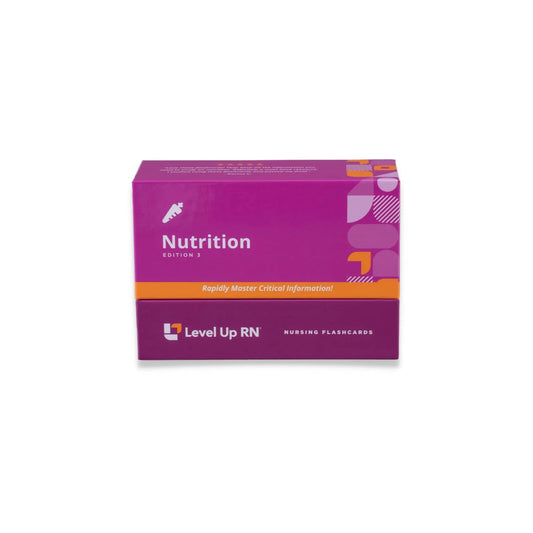Hi, I'm Cathy with Level Up RN. In this video, I will be discussing nutrition during childhood. I covered infant nutrition in a separate video, so definitely check that out. In this particular video, I'll be discussing nutrition for toddlers, school-aged children, and adolescents. And at the end of the video, I'm going to give you guys a quiz to test your understanding of some of the key facts I'll be covering. So definitely stay tuned for that. And if you have our Level Up RN Nutrition Flashcards, go ahead and pull out your Flashcards so you can follow along with me.
Let's first go over some key information about toddler nutrition. In terms of weight gain, toddlers are expected to gain approximately four to six pounds per year, and a toddler's weight will be approximately four times their birth weight at age two and a half. Whole milk should be introduced after age one, and then at two years of age, whole milk should be replaced with 2% milk. Intake of milk should be limited to two to three servings per day in order to prevent iron-deficiency anemia, and here's why. Milk is a great source of calcium and vitamin D, but it is low in iron. So if a child is filling up on too much milk, then they are less likely to eat solid foods, including foods that are rich in iron. In addition, milk decreases absorption of iron. So this is why too much milk can result in iron-deficiency anemia. In addition to limiting milk consumption to two to three servings per day, we also need to limit juice consumption to four ounces per day or less. And then finally, it is super important to supervise the child during mealtime and to avoid choking hazards. This includes anything round or requiring a lot of mastication, such as hot dogs, nuts, seeds, peanut butter, raw vegetables, whole grapes, hard sticky candy, popcorn, and chewing gum.
Next, we have school-aged children, which are expected to gain approximately four to six pounds per year. In terms of nutrition and activity guidelines, a 5-2-1-0 framework is recommended. This includes five or more servings of fruits and vegetables per day, less than two hours of screen time per day, at least one hour of physical activity per day, and zero or limited sugar-sweetened beverages. As a child moves into adolescence, they will require additional calories and nutrients to help fuel the growth that occurs during puberty. In particular, sufficient calcium and iron are essential during this time. And then one key thing that we need to monitor for during adolescence is the presence of eating disorders, such as anorexia nervosa and bulimia nervosa.
All right, it's quiz time, and I've got three questions for you. Question number one. At what age should whole milk be replaced with 2% milk? The answer is age two.
Question number two. Blank anemia in children is often caused by excess milk consumption. The answer is iron deficiency.
Question number three. Why do adolescents need additional calories and nutrients? The answer is to fuel the growth that occurs during puberty. All right. That's it for this video. I hope it was helpful. Thank you so much for watching, and good luck with studying.
[BLOOPERS]
As a child moves into adolescence, they will require additional calories and nutrients to help fuel the growth.


